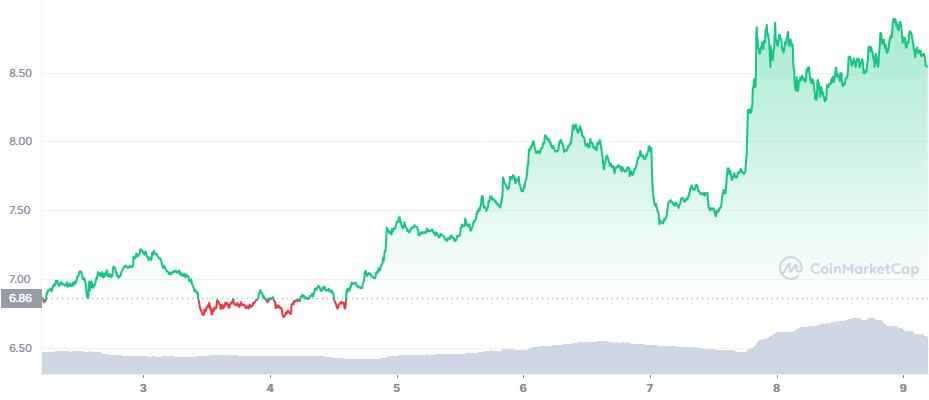Chainlink (LINK) Rallies Again on Roadmap Reveal

Chainlink (LINK) was one of the tokens that exceeded the market expectations during previous bull cycles. Now, LINK is up again, getting ahead of the pack of other altcoins and tokens. Chainlink has become a staple in crypto space, mostly for its oracle services and price-setting mechanisms in a growing decentralized ecosystem.
LINK later lost some attention to Solana and Terra (LUNA), at least before the crash in May 2022. Now, LINK is on an expansion rally again. Almost a top 20 asset, set on displacing Litecoin (LTC), LINK rose to $8.69 in a mid-week expansion, gaining more than 11% in 24 hours while other assets stagnated.
What Caused the LINK Rally
LINK is near a one-month peak as it tries to break above $9 again. The chief reason is the launch of Chainlink 2.0, a roadmap plan that includes LINK staking, a feature that has been awaited by the community for years.
Unlike other protocols, LINK worked on the product first, generating multiple information feeds and oracles for decentralized finance. The community did not need aggressive staking, which would have undermined the asset’s value.
Now, staking will start out with a low return rate of 5%, then may increase but only based on Chainlink revenues from services. Additionally, returns will only increase with supply staked, meaning a lot of LINK may simply disappear from the market.
LINK has a circulating supply of above 467M tokens, out of a total 1B tokens. The first goal is to have 75M tokens locked for staking, with the potential to grow from that level. The current staking hype is also bringing attention to Chainlink, and its instrumental part in the growing crypto finance field.
Chainlink will also bring more than simply price tracking – it will build reserves for market insurance. The current system of price tracking has worked for years, but now Chainlink will offer additional services, while possibly asking for insurance fees. With a first arrival advantage, Chainlink may have the biggest pool in market insurance. And after the crash of Terra, projects may be more willing to pool assets against price crashes.
LINK nodes will now have to show their readiness to stake tokens in order to be selected for oracle services. This move is intended to lead to higher reliability when securing smart contracts.
Chainlink started with a single price pair tracking, an ETH/USD valuation, and now tracks 12 different blockchains and L2 scaling solutions, with more than 50 node operators. Over time, the Chainlink project aims to offer more complex staking mechanisms and tasks based on its price tracking and oracle services.
Are Oracles Reliable
The Chainlink oracle has been reliable enough to be implemented in hundreds of projects and thousands of smart contracts. But price feeds may break during extreme events, which included the LUNA crash in May.
The Chainlink oracle failed to track the current LUNA price due to a previous setting of the minimum price. This led to contagion over automated trading protocols, leading to accrued losses.
Chainlink Continues to Build Partnerships
Chainlink continues to build specific relationships with DeFi protocols, paying attention to the specifics of other blockchains. The latest service was extended to Hedge Labs DeFi protocol on the Solana network.
But Chainlink also goes beyond DeFi and token pricing information, also offering NFT randomization services.
Chainlink will provide a service known as “verifiable randomness”, which can assign traits with a truly random generated number. Chainlink has offered its services to NFT collections like Bored Ape Yacht Club, and smaller mints when selecting NFT traits or distributing to users in a provably fair manner.
How High Can LINK Go
LINK has been one of the assets supported by a loyal following. Now, the evidence that Chainlink is indispensable for crypto space once again brings expectations of a higher valuation for LINK.
The asset peaked above $52.20 in the summer of 2021, sparking expectations of a full retrace of previous levels.
For the most optimistic expectations, LINK may rise as high as $100. Others expect the price of LINK to continue rising as staking progresses, especially after the initial hype. LINK may also spark buying based on the hope that an asset priced under $10 may offer more significant upside.
Even in a bear market, Chainlink may be highly important, ensuring there would be no more unexpected events based on smart contracts misreading prices. Additional demand for LINK may come as more operators attempt to come online and seek to have the required token reserves for staking.

Uphold makes buying crypto with popular currencies like USD, EUR and GBP very simple with its convenient options to swap between crypto, fiat, equities, and precious metals.

With over 50 coins and an obsession with security, Kraken is one of the safest places to buy and trade crypto.

Kraken has a good reputation for security and protection of your funds and operates across the USA (except NY), Canada, the EU and Japan

Based in Charleston, South Carolina. Serves over 184 countries and has done over $4 billion in transactions. Offers convenient options to swap between crypto, fiat, equities, and precious metals.

Crypto investment remains unpredictable and risky, but good practices can save you from many of the potential pitfalls.

A beginners guide to candlesticks, trend line, indicators and chart patterns

IOTA is a feeless crypto using a DAG rather than a blockchain. It aims to be the currency of the Internet of things and a machine economy.

The first cryptocurrency. It has limitations for transactions but it is still the most popular being secure, trusted and independent from banks and governments.